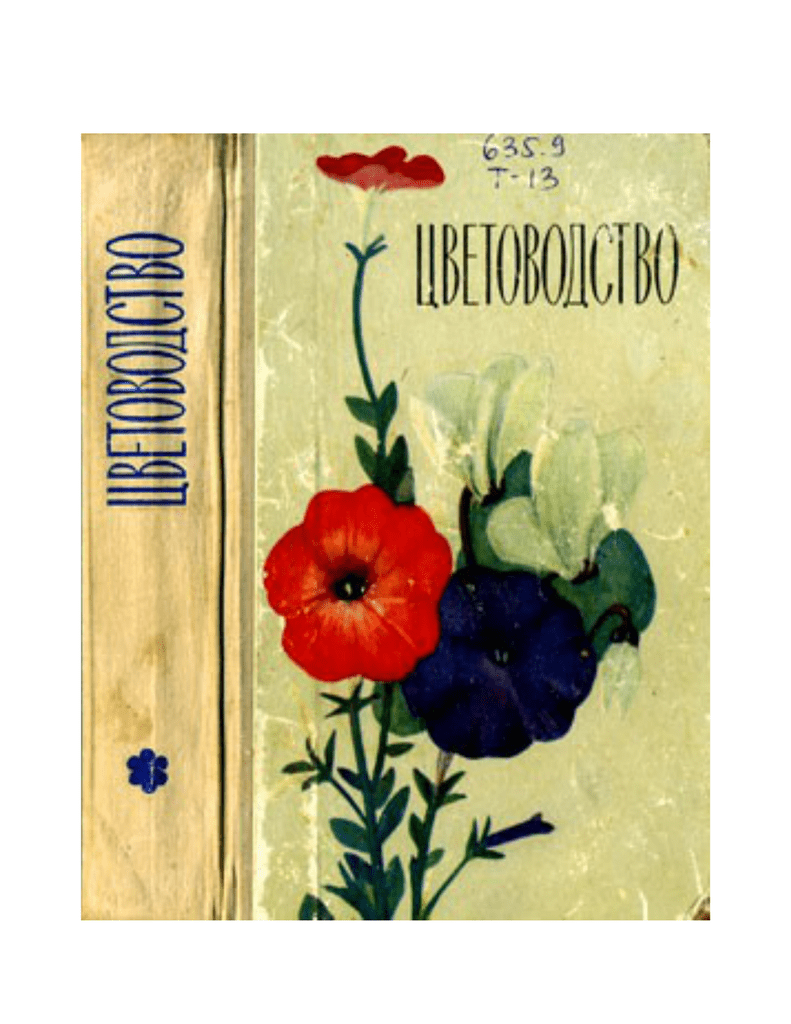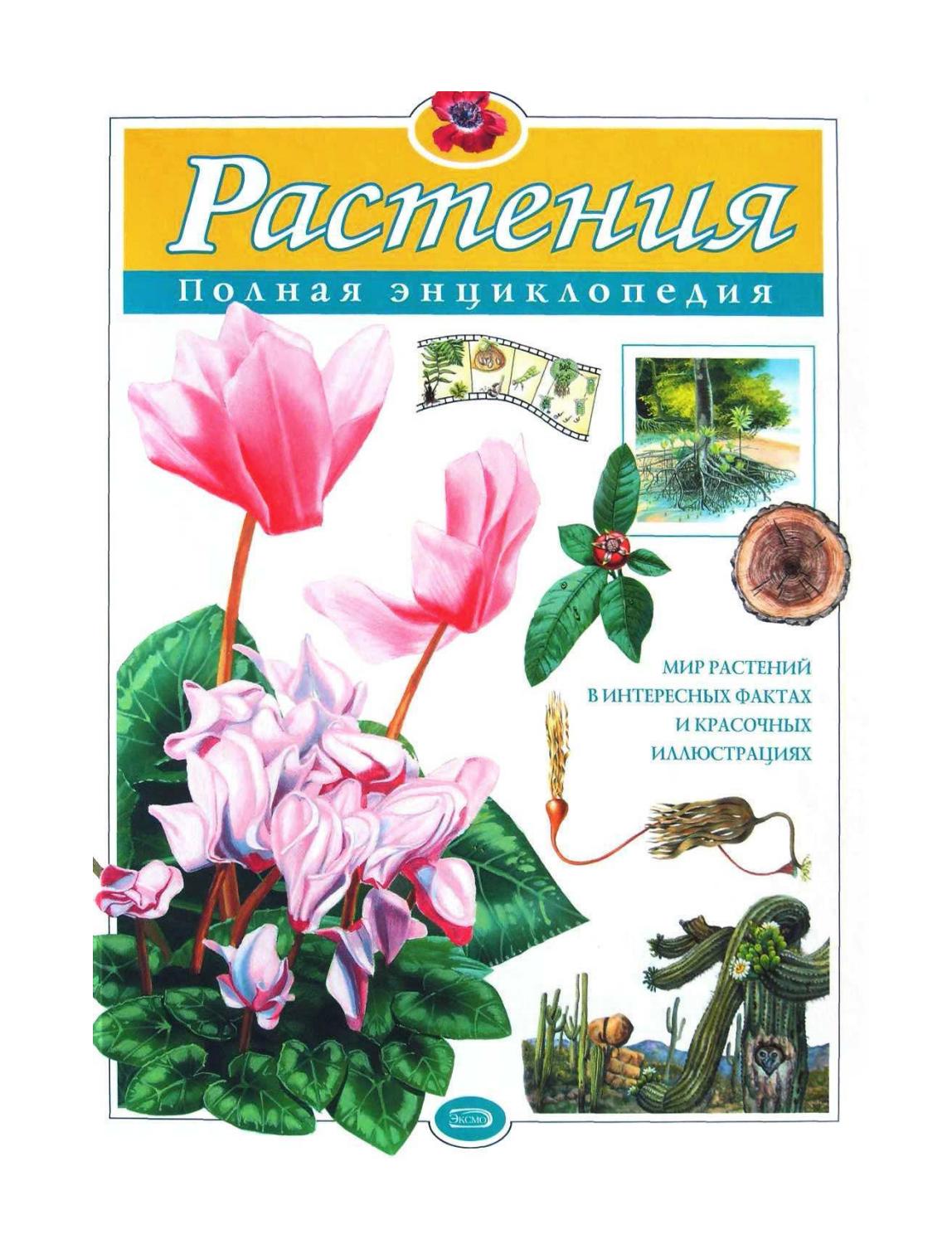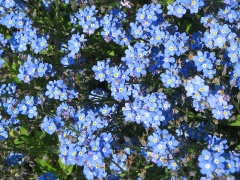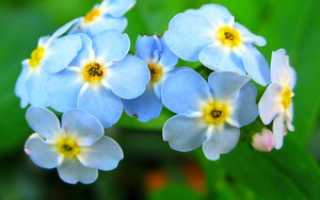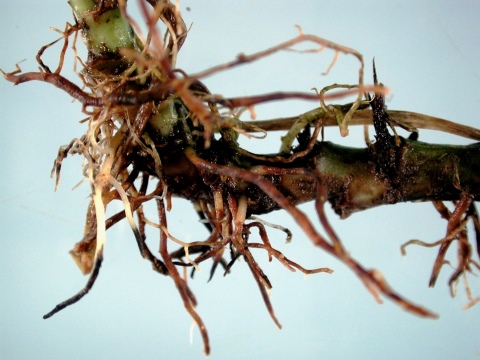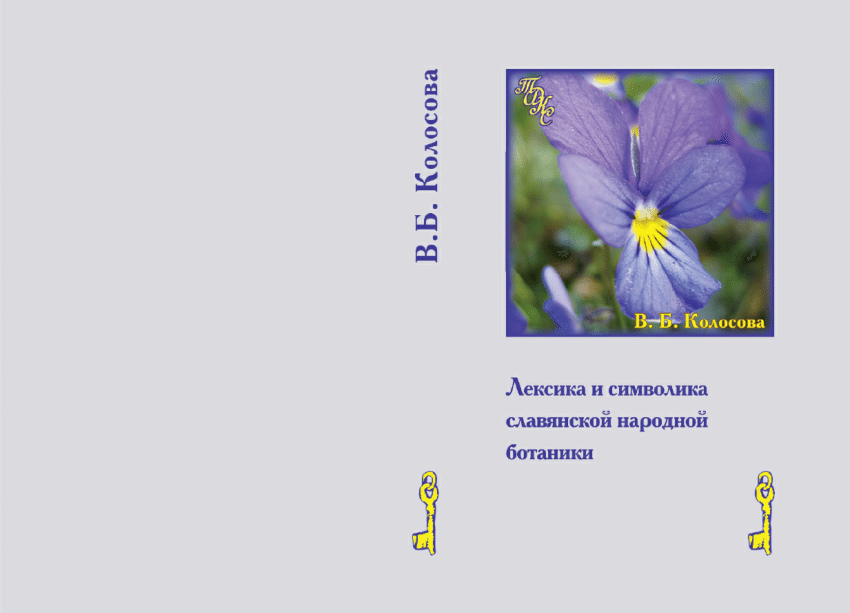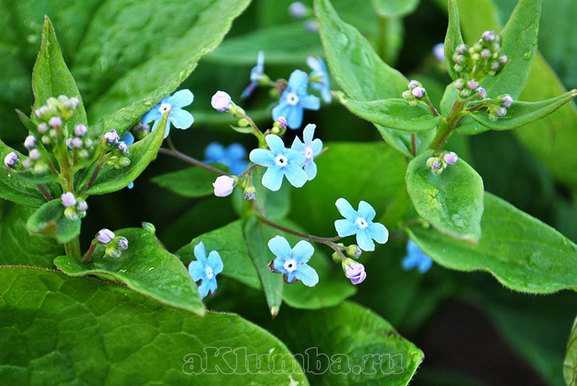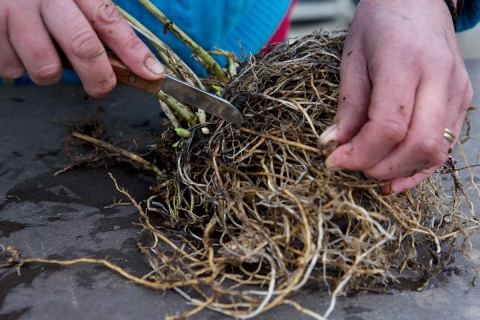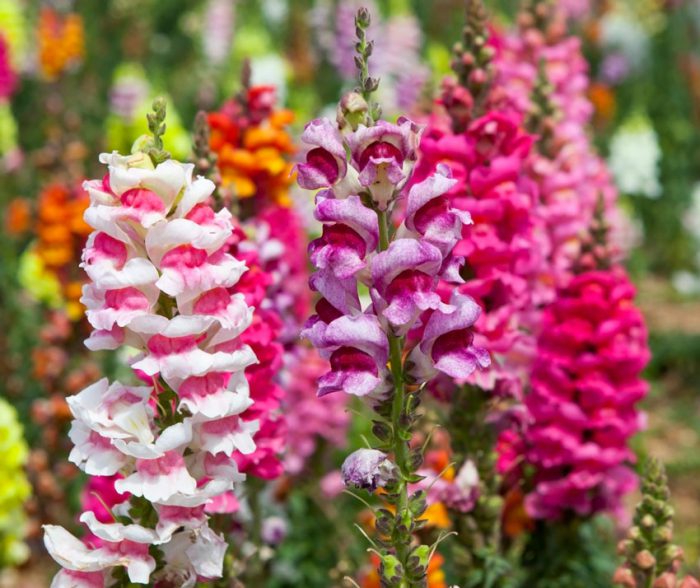Outdoor care
Despite the fact that forget-me-nots are light-loving flowers, a shaded area would be the best option for them. At the same time, you should monitor the soil moisture near the flower bed with the plant. If the soil is too dry, the flower may die. Flowering and its duration also depends on the area where the flower is planted. In a sunny area, the plant will bloom for only 3 weeks, while in a shaded area up to 2 months. The note! Exceptions are field and alpine species and varieties. A common garden blue forget-me-not grows well with larger, taller flowers that shade it. In most cases, the plants are grown for 2 years, after which they are sown again. In the third year, the stems of the plant are too elongated, and the diameter of the flowers becomes smaller. For soil, moderately damp soil with a little fertilizer is ideal.
If the soil is oversaturated with moisture, the plant will stretch out, the stem will become thinner, and the flowers will be smaller. Too dry soil will not work. Watering should be carried out as the soil dries up, depending on the weather conditions, the forest clearing of forget-me-nots on your site should not be oversaturated with moisture. If the plant is grown in the sun, the volume of water for irrigation is increased. It is not necessary to water the flower bed in the spring. Fertilizers are applied only 3 times: Before planting the plant in the ground. Before flowering, after germination. In the autumn. It is better to use liquid mineral mixtures for flowers as a fertilizer. These can be purchased at any gardening store. In autumn and spring, the meadow is fertilized with peat and humus.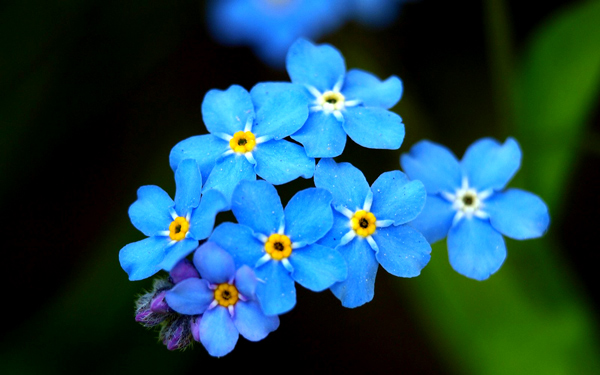
Note! Forget-me-nots love fresh soil, so it must be loosened periodically. As for weeding, it must be carried out as soon as weeds appear on the plantation.
When to plant forget-me-nots? Seedling method of growing: Annual plant - sow in late February-early March. Biennial Plant - Sow May-June. In late August and early September, seedlings are transplanted to a permanent place. For forcing plants in winter, seeds are sown in late February and early March. Further, the terms are as follows: in July-August, the obtained seedlings are transplanted into pots, at the end of September the pots are brought into cool rooms with temperatures up to 0 ° C, in February they are brought into a warm apartment. How to use in landscaping? Forget-me-not will be an excellent option for decorating a flower bed, flower garden or balcony.
Many varieties of flower can be grown at home. When choosing a place for planting forget-me-nots, it is worth considering the type and variety of this plant, the marsh one will perfectly decorate an artificial pond, the garden one - a flower bed, the alpine one will look great among the stones. Forget-me-not goes well with tulips, lilies of the valley, daffodils. Daisies and pansies will also look great in the flower bed next to her. You can replace forget-me-not when it comes to the selection of plants for shaded and moderately humid areas of the garden: lungwort, small-bulbous, daffodils, crocuses, chiostophyllum.
Location and lighting
Flowers will grow well both in the shade and in the sun. But in a shaded place, they will bloom longer, acquiring a more saturated shade.
The soil
For forget-me-nots, moderately moist meadow soil is suitable. Too nutritious soil is not suitable for them, since the plant will grow vigorously and bloom poorly. Poor sandy soils are also not suitable for the plant. If you plant a forget-me-not in an excessively wet area, it will hurt and stretch out a lot in length.Therefore, the ideal conditions for growing these beautiful flowers are in moderately humid areas with a small amount of fertilization.
Watering rules
If the forget-me-not grows in the shade, watering the plant should be moderate. In late spring, it is not necessary to water the flowers, since the soil contains the required amount of moisture. When forget-me-nots grow in sunny areas, watering is increased so that its leaves always remain fresh and elastic.
Fertilizers and feeding
It is not worth feeding the plant too often. Fertilizers are applied to the soil three times. Young forget-me-nots must be fed two weeks after planting, before flowering. For this, liquid mineral fertilizers are used. Organic and mineral fertilizers must also be applied in the fall. And in the spring, a small amount of peat and humus is introduced into the soil. Since forget-me-nots are more fond of fresh soil, it is regularly loosened so that all the necessary nutrients come to the plant. Flowers do not need additional shelter for the winter.
Forget-me-not flowers practically do not require weeding, as they have a powerful fibrous system that does not allow weeds to break through.
Seed propagation - features of growth
A distinctive feature of forget-me-nots is good self-seeding reproduction. However, with no less success, you can grow a plant from seeds on your own. In May-June, forget-me-not seeds are placed in a cold greenhouse, and the seedlings are planted in a permanent place at the end of August or next spring.

Forget-me-not reproduces well by self-sowing, so it will not be difficult to grow it from seeds
If we are talking about varietal forget-me-nots, I use propagation by cuttings 4-5 cm long, which are harvested in May-June. They are planted on the ridges, after which they are shaded.
If you want to see a beautiful bloom already in the spring, then you can sow the seeds in October-November. For planting, a container with a hole in the bottom is required. It is filled by two-thirds with sod land and a third with river sand. Before sowing the seeds, spill the soil with a pink solution of potassium permanganate. Seeds are sown randomly from above. It is not necessary to deepen them, so they will germinate better and faster.

Forget-me-not seedlings appear 4-6 days after sowing the seeds
Before sowing, you can check the quality of the seeds. They are dipped into lightly salted water and their buoyancy is monitored. Sinking seeds are selected for sowing, while floating seeds are rejected. Seeds selected for sowing are dried and sown. From above, you can lightly sprinkle them with light soil, and then compact it with a board. Seedlings will make themselves felt in 4-6 days, and until that moment, the boxes with seeds are covered with paper, and watering is carried out on it.
When the seedlings have two real leaves, it is time to dive into boxes or pots filled with peat soil. The distance between the plants is 3-4 cm. The boxes are taken to a cold greenhouse until March, and then brought to a warm room. Forget-me-not will not need additional lighting, since she loves shade. But the soil must always be kept moist.
In June or July, when flowering ends, forget-me-not loses its attractiveness, and therefore it can be removed from the flower garden, with the exception of two or three plants, which are needed to collect seeds.
Forget-me-not - general description
Forget-me-not belongs to the borage family and can be either one-year or two-year-old. The erect, branched stem is covered with protruding hairs and reaches up to half a meter in height. The roots of the plant are short, pivotal. The alternate leaves are gray-green in color and when they only hatch from the buds, they are very similar to mouse ears.
Forget-me-not flowers collected in inflorescences are usually pink, blue or white with a yellow core. It blooms from late May to mid-June. There are such varieties of forget-me-nots in which flowering continues until the beginning of autumn.Fruits are black or dark brown triangular ovoid nuts with shiny black seeds inside, ripen in June.
Medicinal properties and harm
The use of forget-me-not in folk medicine is based on the medicinal properties of the plant, which include:
- anti-inflammatory;
- hemostatic;
- expectorant.
The complex of these properties determines the leading direction of using the plant - the fight against infections of the respiratory tract, lungs, eyes, skin and digestive organs. The high content of tannins can successfully block the growth of microorganisms, mucous saponins provide relief from coughs and other symptoms of the common cold, and flavonoids eliminate capillary fragility.
The plant does not contain toxic substances, however, in cases of individual intolerance, pregnancy and lactation, it is better to refrain from using it.
Folk legends
In our country, forget-me-nots have other names, for example, they call it a pristine, feverish herb, gourd. Different peoples have different legends associated with this flower, but they are all united by the concept of loyalty and good memory. In Greece and German folklore, there is a legend about a shepherd named Likas, who gave his bride, saying goodbye to her, a bouquet of forget-me-nots.
They also remember the ancient legend of a couple in love who went for a walk along the river. At the edge of the steep bank, the girl noticed a delicate blue flower. The young man climbed down to tear him down, but could not resist and found himself in the river, which caught him with a strong current. All that he had time to shout, before the wave covered him is: "Do not forget me!". This is one of many legends about a lovely blue flower with a yellow eye, telling how it got its interesting name.
This flower is considered by many to be witchcraft. Since a woven wreath made of it and put on the neck or placed on the chest in the region of the heart of a loved one is able to bewitch and hold him stronger than chains. The roots of forget-me-not have the same power.
How to plant and grow forget-me-nots
It is not difficult to grow flowers from seeds. Sowing and planting are the same regardless of the species. But each variety should be looked after individually, because of the needs of each of them in certain living conditions.
Sowing seeds:
- loosen the soil and add fertilizers - peat, humus;
- distribute peat in cells or disposable glasses;
- make recesses in the center (2 cm) and place seeds there;
- sprouted seedlings are planted in the ground in the spring.
Seeds sprout within two weeks. If sown in this way, the plant begins to bloom earlier. It is better to use a special soil for planting flower crops. After germination, the seedlings are placed in a cool place - a greenhouse, before planting. Seeds sprouted in this way grow faster, and delicate flowers bloom much earlier.
You can also sow in open ground, only after the first leaves hatch, the plants should be thinned out or transplanted to another place. The distance between plants should be at least 5 cm, and between rows - 10 cm.
Growing evening primrose in the garden
Planting evening primrose
A sunny area is best for growing a primrose, but it can also grow in a little shade. The composition of the soil for such a plant is unimportant, however, those areas that are swampy or excessively wet are not uniquely suitable for it. The fact is that it belongs to those plants that tolerate drought better than stagnant water in the ground. Evening primrose will grow best on light sandy soil with a pH of 5.5-7.0.
If you decide to decorate your plot with evening primrose, which is a biennial, then you can grow it through seedlings. In the last days of February or the first days of March, seeds are sown in seedling boxes filled with a suitable substrate.After the seedlings that have appeared grow up and get stronger, they are planted in open soil, while keeping a distance of 0.5 to 0.6 meters between the bushes. The seed can, if desired, be sown directly into the open soil. Sowing is carried out in the last days of April or the first - in May, and you can do this before winter. Seeds are sown in moistened soil in 2 or 3 pieces, while they need to be buried in the ground by 5-10 millimeters. When sowing, you need to adhere to the 30x30 centimeters scheme. But first, it is necessary to prepare the site, for this they dig it to an average depth, at the same time fertilizer must be added to the soil, so, 3 kilograms of humus (compost) and 2 tbsp are taken per 1 square meter. Nitrofoski. After the appearance of seedlings, they need to be opened, keeping a distance of at least 10 centimeters between the bushes. Plants may need a few more thinning, depending on the species and variety, as a result, each of the bushes should have a sufficient feeding area. During the first season, the formation of a basal leaf rosette and a root system is observed in perennial and biennial primrose trees, while flowers and peduncles grow only in the next year.
Evening evening care in the garden
Young bushes are watered systematically 1 time in 7 days until they are completely rooted. Adult plants need watering only during a prolonged dry period. When the plant is watered or it rains, it is imperative to loosen the soil surface around it while pulling out all the weeds.
If, during the preparation of the site for planting, all the necessary fertilizers were not introduced into it, then in the spring it will be necessary to carry out foliar feeding with a weak solution of a mullein. If all the necessary fertilizers have been added to the soil, then the bushes will need to be fed during flowering by the root method and use a complex mineral fertilizer for this. During the flowering period, wilted flowers must be regularly removed from the bushes and this must be done, thanks to this, the flowering will be longer, while the evening primrose will not be able to reproduce by self-sowing.
In some species, the root system gives growth after growth. In order to limit the growth of roots, around flower beds in the ground on a depth of about 25 centimeters, it is necessary to dig in sheets of metal or slate. Evening primrose grows very quickly, in this regard, at the first signs of degeneration, the plant must be removed from the soil, divided into several parts and plant on a new site. It is recommended to carry out this procedure at least once every 3 or 4 years. In the last days of the season, when the flowering is completely over, the two-year-old primrose must be dug up and burned, while the ground part of the perennials is only cut off.
Perennials do not need shelter for the winter. However, if, according to forecasters, the coming winter will be little snow or frosty, the bushes in late autumn should be covered with compost or peat.
The healing properties of the lamb
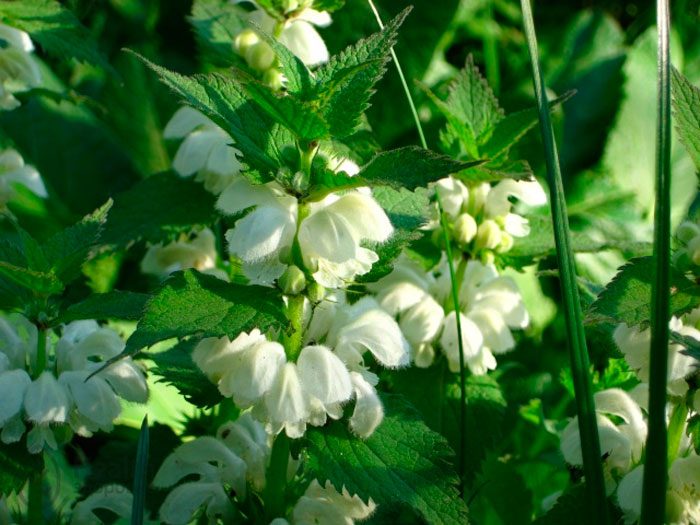
Lamb is a medicinal plant. Its healing properties are due to the content of a large number of useful substances, while the most important of them are: alkaloids, flavonoids, essential oils, ascorbic acid and tannins.
Infusions based on this plant are used for sore throat, serious inflammation, or as a diuretic. In order for open wounds to heal faster, herbal lotions are applied to them. Hot baths with clear water help with gynecological diseases.
Before using lambda for the first time as a medicinal plant, it is recommended that you always consult with your doctor. There are practically no contraindications to the use of clearcoat. However, individual intolerance to the substances that make up the lamb is rarely found, which can cause the development of allergic reactions.
JASNOTKA || Useful properties and application
Diseases and pests
Forget-me-nots are considered hardy plants, they are rarely exposed to diseases or pests. Most often, such problems arise when the rules of agricultural technology are not followed and recommendations for plant care are violated.
One of the most common pests of garden flower crops is aphids. The fact that forget-me-nots suffered from this parasite is evidenced by inhibition of shoot growth, drying and rolling of leaves. The affected bush looks weakened, lethargic. The parasite can be found during the examination inner side and axils of leaveswhere whole colonies of aphids often accumulate.


Drying of plants, twisting of leaves and dying off of shoots are characteristic signs of a spider mite attack. Also, small clusters of grayish-white cobwebs on the leaves and stems of forget-me-nots indicate its presence.


Improper watering and excessive thickening of plantings can become the reasons for the development of powdery mildew in forget-me-nots. This disease is characterized by the appearance of dirty gray and brown spots on the leaves of plants.


Violations of the irrigation regime and stagnation of water in the soil often become the reasons for the development of root rot. With this dangerous disease, plants begin to become covered with gray, dirty yellow or rusty brown spots. Often, an unpleasant putrid smell begins to emanate from the affected flowers.

Orchis care
Orchis, which is also called the wild orchid, grows well in the open field. At the same time, the flowering of garden varieties is more spectacular than that of wild plants. However, in order for the bushes to bloom magnificently and for a long time, optimal conditions for their growth should be created.
Lighting
Best of all, such a flower grows in light partial shade, while the lighting should be diffused. Unlike wild species, garden varieties grow well in sunny areas, the only thing they cannot be planted in the shade. But at the same time remember, the more sunlight on the site, the more difficult it is to care for such a plant.
Priming
Orchis will grow well only on nutritious and moist soil, and it must be very loose. Also, it must be well-drained.
Pay particular attention to soil moisture. Wild orchid reacts extremely negatively to the stagnation of liquid in its roots, however, it prefers to grow in moist cool soil, and it should remain so even on hot summer days
Worst of all, such a flower grows in dense soil, as well as in soil fertilized with fresh manure. When preparing a hole for planting a plant, it is recommended to mix the soil pulled out of it with peat (1 part) and with sand (0.5 parts).
Watering
The orchis grown in a well-lit area needs systematic, timely watering. If the plant is rarely watered, then the flowering will be poor and short-lived. And it is also necessary to water regularly those bushes that are grown in an area with depleted soil.
In the event that moist loose soil was chosen for planting such a flower, then it will need to be watered only if necessary. During periods of prolonged drought, be sure to water the wild orchid, preventing the soil from drying out and overheating.
Watering such a crop is necessary in such a way that the soil on the site is constantly slightly moist. The plant is equally harmed by overdrying of the earth and stagnation of liquid in the root system.
Fertilizer
It is highly undesirable to feed the garden orchis with mineral fertilizers. For a spectacular and lush flowering, it is recommended to feed the bushes with organic fertilizers. They not only make up for the lack of nutrients in the soil, but also improve its structure.
Needles and compost are great for feeding such a plant. They are recommended to be brought into the ground during the preparation of the site for planting the orchis.They are also used as mulch; for this, the soil surface around the bushes is covered with a thick mulch layer 2 times during the season (at least 50 mm). It is recommended to mulch the bushes in the middle of spring and in the first days of September.
Wintering
The wild orchid is not a thermophilic plant. It is characterized by a fairly high resistance to frost and is able to survive the winter without shelter, even in mid-latitudes.
Despite this, the plant must be prepared for wintering, as it can suffer due to stagnant moisture in the soil, as well as due to sudden temperature changes during a thaw.
Orchis preparation should be done in the fall. When you notice that the above-ground part of the bush has begun to dry out, it must be completely cut off to the very base. At the same time, it is highly undesirable to wait until the stems are completely dry and die off themselves. All experienced gardeners recommend that it is imperative to carry out a cardinal pruning, without fear of harming the plant. After pruning, the root system will be well prepared and will not be intimidated by any winter.





